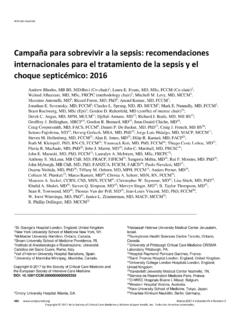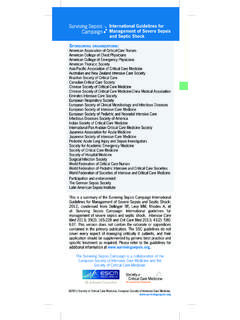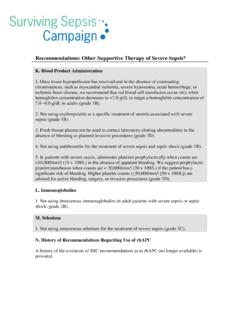Transcription of Getting Started - Surviving Sepsis Campaign
1 EducationThe SSC leadership believes that continuing education is the most important factor for initial and ongoing SSC success. A variety of educational tools is available to institutions to support the learning process. Teaching tools include:The website will be updated as new offerings are available including webcasts, PowerPoint programs, videos, and other resourcesSSC educational offerings at partner society s conferencesSSC guidelines poster 2012 guidelines SSC pocket guide 2012 guidelines bundle badge cards Surviving Sepsis Campaign lapel pins to show your team s commitmentFor further assistance, please contact Stephen Davidow at the Society of Critical Care Medicine by phone at +1-847-827-7088 or by email at Getting StartedThe Surviving Sepsis Campaign In Your Institution.
2 Getting StartedThe Surviving Sepsis Campaign (SSC) partnered with the Institute for Healthcare Improvement (IHI) to incorporate its bundle concept into the diagnosis and treatment of patients with severe Sepsis and septic shock. We believe that improvement in the delivery of care should be measured one patient at a time through a series of incremental steps that will eventually lead to systemic change within institutions and larger health care systems. Local SSC implementation is the key to mortality reduction for severe Sepsis and septic shock patients. Successful SSC adoption requires a hospital champion who can coordinate the LEADER steps outlined below. L Learn about Sepsis and quality improvement by attending local and national Sepsis meetings.
3 E Establish a baseline in order to convince others that improvement is necessary and to make your measurements relevant. This should be done prior to formal improvement efforts. Start by collecting data on all severe Sepsis patients in your intensive care unit (ICU) - you may see only one or two patients per day. A Ask for buy-in from institutional leadership and seek initial support from the emergency department (ED) and ICU staff and directors, quality improvement personnel, nursing staff, and others. (You may want to watch the webcast Administrative Buy-In: Key to Sepsis Care Improvement Form a Sepsis team and bring all stakeholders to the table for input. Tell people what you are doing and why. You may not receive initial support across the board, but opinions often change when data start to become available.)
4 Publicize the SSC with a formal kick-off event. Highlight several physicians to speak about the effort and invite representatives from administration, medicine, nursing, respiratory therapy, and pharmacology. This commitment will provide early momentum and drive improvement efforts forward. Getting Started Getting StartedD Develop an institution-specific SSC protocol comprising all bundle elements. Seek feedback and refine your protocol to the satisfaction of your team. Assign a protocol owner with the task of refining the protocol and patiently obtaining feedback from all comments and suggestions at regular team meetings. Publish refinements by scheduled deadlines and label each version with a date to ensure uniformity of use.
5 E Educate stakeholders in the ED and ICU and floors according to shift schedules. Post the SSC protocol in several prominent staff with the bundles and your protocol. Explain the importance of the bundle tools. Tolerate failure and revise teaching as Remediate errors and anticipate obstacles along the way. Recount successes and failures every month. The SSC database can create graphs that benchmark your success and demonstrate powerful visuals of clinical targets where improvement is important. Everybody involved needs to see what is happening to drive the SSC effort forward. Identify critical failure modes as a team and redesign processes as needed while simultaneously measuring your results. How To Improve Forming The Team To achieve the improvement goals, everyone involved with the care of the severe Sepsis patient must be included, work processes must be carefully scripted and standardized, and awareness and commitment to this effort must be elevated.
6 This must be a team effort that crosses disciplines and departments; it requires leadership and support from the entire organization and buy-in from all stakeholders involved with the care of these patients. There are three different levels of participation in creating successful change: Active working team responsible for daily planning, documenting, communication, education, monitoring, and evaluation of working team must be multidisciplinary, with representation from all departments involved in the change processes doctors, nurses, pharmacists, respiratory therapists and other staff with roles in the specific change process, such as clerks and technicians. Team members should be knowledgeable about the specific aims, the current local work processes, the associated literature, and any environmental issues that will be affected by these changes.
7 The leadership group or person who helps remove barriers, provides resources, monitors global progress, and gives suggestions from an institutional perspective is essential. The working team needs someone with authority in the organization to overcome barriers that arise, and to allocate time and resources the team needs to achieve its aim. Leadership needs to understand both the implications of the proposed changes for various parts of the system and the remote, unintended consequences such a change might trigger. Providers, including all stakeholders who have an interest in the change, must be are needed to keep providers and other stakeholders informed, provide a hassle-free mechanism to receive their feedback, and assure them that their responses are respected and will influence the changes.
8 This helps give them some ownership and facilitates implementation and utilization of the new processes Getting StartedExamples Of Effective TeamsExample 1: Effective Work Team Aim: Diagnose patients with severe Sepsis or septic shock in the emergency department (ED) within 2 hours of triageCore Working Team: The overall core team must be interdisciplinary and must include, at a minimum: ED physician Triage nurse Staff nurse Laboratory technician Laboratory supervisor Admissions clerkAdditional team members may include: Critical care medicine (CCM) physician House officer ICU charge nurse Infectious disease physicianExample 2: Effective Work TeamAim: Ventilated septic patients will have tidal volumes near 6 ml/kg ideal body weight and plateau pressures less than 30 cm H2O Core Working Team: The overall core team must be interdisciplinary and must include, at a minimum: CCM physician Respiratory therapist Staff nurse Pharmacist Getting Started Getting StartedAdditional team members may include: Private attending physician Surgeon ED physician Blood gas technicianExample 3: An Effective Leadership Team Aim: ED and CCM will join to implement best possible care for septic patients, using the known evidence that fits their institution.
9 Core Leadership Team: The overall leadership team must be interdisciplinary and must include, at a minimum: Administrator over ED and CCM Critical care medicine physician ED physician CCM nurse manager ED nurse manager ED charge/triage nurse CCM charge nurseAdditional team members may include: Pharmacist Respiratory Therapy supervisor Process improvement facilitator Laboratory supervisor Technicians from ED Establishing And Engaging Measures To Track ChangeProcess MeasuresThese measures tell you about how the process of change is unfolding as your improvement and clinical teams work to comply with the bundles. Are changes being translated into actual practice as you intended them to be?
10 Process measures will allow you to identify whether you have created a reliable system that follows the timing, sequence, and goals mandated in the Sepsis Bundles. Outcomes MeasuresThese measures tell you whether changes are actually leading to the improvement you intended. Faithful implementation of the Severe Sepsis Bundles, combined with an unwavering focus on the above process measures, will help you to achieve this goal at your institutionData CollectionA hospital s improvement team is likely to use one of two methods to collect data for the measures described above. Whichever method is selected, that approach should be maintained from month-to-month in order to assess the degree of improvement over time accurately.











